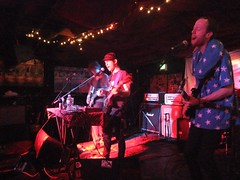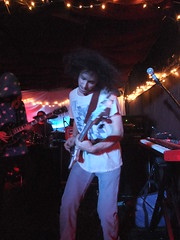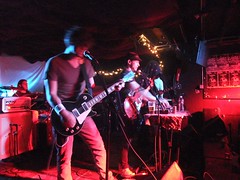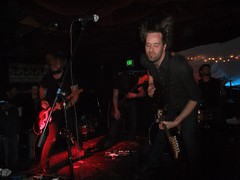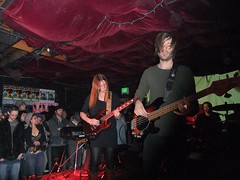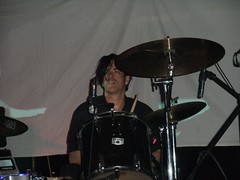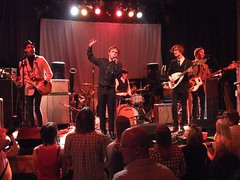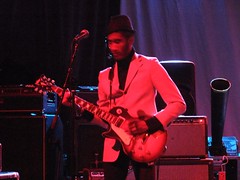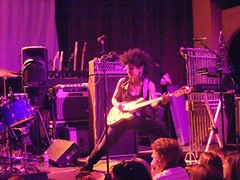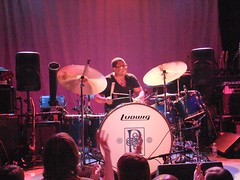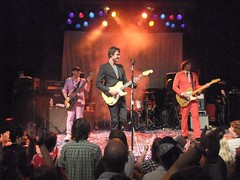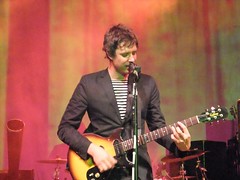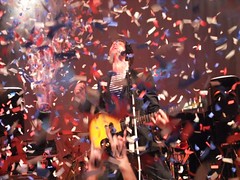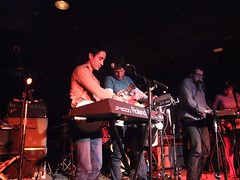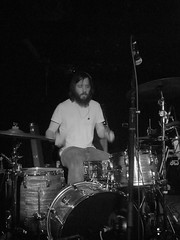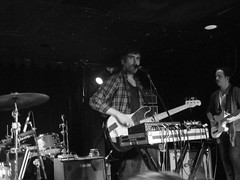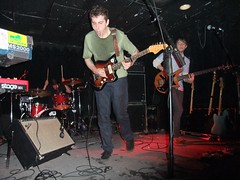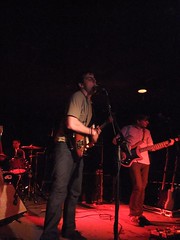 Capturing lightning? Earlier, the Jonestown Potion's live show blew my mind. How does their self-titled CD measure up? The jazz centric jam band mixes a tossed salad of styles and influences, both across the disc as well as within any given song. Those influences include Frank Zappa, King Crimson, Ozric Tentacles, and Miles Davis. At their roots, the Jonestown Potion are locked in on Davis' electric jazz fusion period. The other bits swirl by, waiting for some quick recognition, then drifting off. During their performance, this flowed naturally. While this often works on the album, too, some of the stylistic jumps feel a little rough and contrived. That shouldn't detract from this ambitious album, though.
Capturing lightning? Earlier, the Jonestown Potion's live show blew my mind. How does their self-titled CD measure up? The jazz centric jam band mixes a tossed salad of styles and influences, both across the disc as well as within any given song. Those influences include Frank Zappa, King Crimson, Ozric Tentacles, and Miles Davis. At their roots, the Jonestown Potion are locked in on Davis' electric jazz fusion period. The other bits swirl by, waiting for some quick recognition, then drifting off. During their performance, this flowed naturally. While this often works on the album, too, some of the stylistic jumps feel a little rough and contrived. That shouldn't detract from this ambitious album, though.The album is littered with clever titles that don't often provide much clue about the songs. So we have the short, Zappa-esque Beaux Flecks, the Emerson, Lake, and Palmer vibe of General Dogmeat, or Chocolate Warhead's tribute to Dave Brubeck's Take Five. This all reflects a band that doesn't take itself too seriously. Despite the meta-joke of the titles, the playing is all tight and focused.
A couple of tunes really stand out. Like most of their songs, Tumble Junky goes through a number of musical phases. It leads off with a bop groove into a Jeff Beck style song, sort of like Freeway Jam with a touch of horns from Zappa's Mothers of Invention. The bass line here is busy and rocking, I almost missed it because so much was going on around it, including some nice sax work. The changes, especially in the bop section are tight. After working the main theme, the song shifts phase again to grind down into a Charlie Hunter style slow blues jam. This gives Eli Cagen another chance to cut loose on a moodier sax solo. The organ solo during this section recalls Al Kooper's work on Super Session.
The moody and introspective Dancing Grannies also moves through its own set of stylistic hoops. It starts out with a laid back bass driven groove, backed by loose drumming in 7. That shifts time signature to a break section in 8. These parts alternate, with smooth transitions on the time change. There are some casual, noodling leads on keys and later guitar, while the horns throw in some nice texture. Maybe it's the interesting beat, but it reminds me of Brubeck again. After a couple of times around, it picks up some intensity, adding some fuzzed out guitar to the break. Back to the main theme, there's some easy call and response work between the strings and the horns. The song shifts into more of psychedelic rock jam ending.
Other notable tracks include Saint Jemima's Satanic Baby Shower, which mutates a rolling piano centered jazz jam into Ozric Tentacles style space psychedelia, Venetian Finger Trap, with its flip-flop mood swings, and Dish of Ants, which starts out experimental but settles into a straighter modal jazz sophistication.
Visit the Jonestown Potion's MySpace page to listen to a number of their songs.
My personal Jonestown potion would have to be my friend Kyle's "Mead For Mere Mortals", a Hatch chile infused sweet mead. Strange and challenging? Sure, but well worth the experience.

